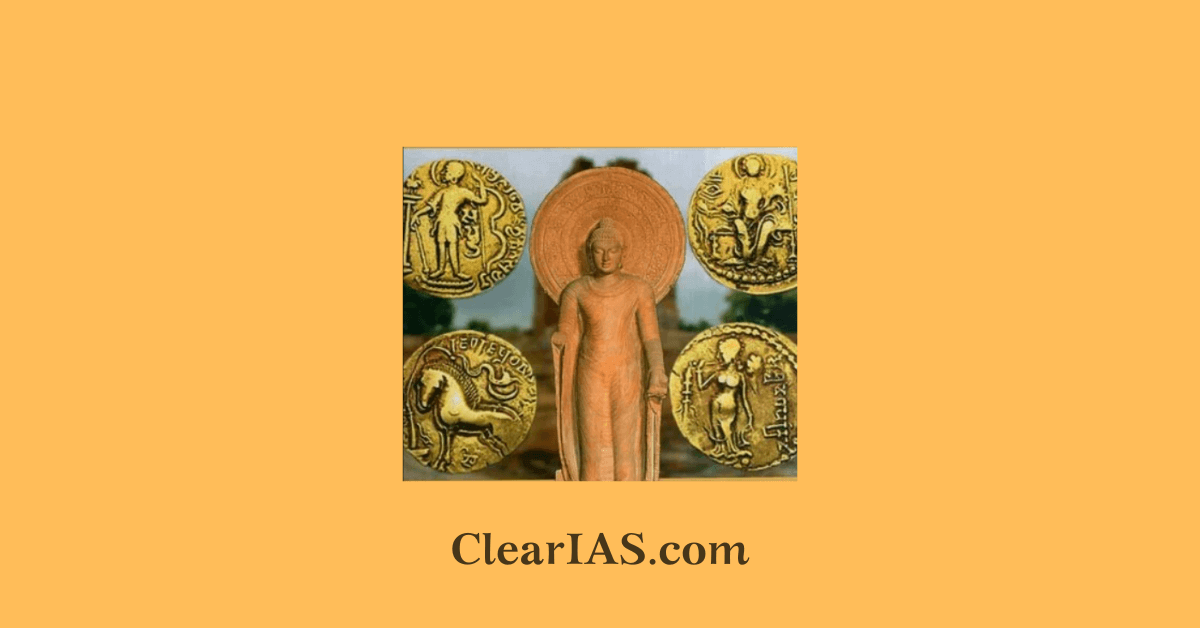
This article on ancient India covers Gupta and post-Gupta rulers. The compilation based on NCERT texts will also help you learn the cultural history of India. The reference material for this post is NCERT History text for Class 6 (Our past -1). Read here to learn more.
NCERT History Text: Standard 6: Only the main points from each chapter are compiled below. Our advice is to first go through the respective NCERT text and use this compilation then for quick revision. We believe that this listing will come in handy during exam time.
The Gupta Empire was an ancient Indian dynasty that ruled over a large part of the Indian subcontinent from around 320 to 550 CE. It is often referred to as the “Golden Age of India” due to its significant contributions to art, culture, science, mathematics, and governance.
Gupta and Post-Gupta Empires
The Gupta Empire was founded by Chandragupta I, who established the dynasty around 320 CE in Magadha, in present-day Bihar, India. The empire rose from the ashes of the Indo-Greek kingdoms.
Chandragupta I’s son, Samudragupta, expanded the empire’s territory through military campaigns, encompassing much of northern and central India.
Guptas
- Information about their history through inscriptions and coins.
- Chandragupta was followed by Samudragupta.
- Samudragupta, Gupta ruler (1700 years ago, ie AD 300). Harisena was his court poet.
- Chandragupta, his father, was the first ruler of the Gupta dynasty to adopt the grand title of Maharaj- adhiraja, a title that Samudragupta also used.
- “Prashasti” = inscription ‘in praise of’. Prashasti about Samudragupta was inscribed on the Asokan pillar at Allahabad (Prayag).
- Four different kinds of rulers in different parts of India/Nepal/Srilanka either surrendered to him or made alliances. (Eg: Aryavartha, Dakshinapatha, gana sanghas etc).
- Main centers of Guptas: Prayag (Allahabad, UP), Ujjain (Avanti, MP) and Pataliputra (Patna, Bihar).
- Samudragupta’s son = Chandragupta II. Kalidasa and Aryabhata adorned his court. He overcame the last Sakas.
Harshavardhana & Harshacharita
- Information about their history through biographies.
- He belonged to Pushyabhuti Dynasty when the Gupta Dynasty was fading.
- His court poet, Banabhatta, wrote his biography, the Harshacharita, in Sanskrit.
- Xuan Zang spent much time at Harsha’s court and left a detailed account of what he saw.
- Harsha took over the kingdom of Kanauj and then led an army against the ruler of Bengal.
- Although he was successful in the east and conquered both Magadha and Bengal, he was not as successful elsewhere.
- He tried to cross the Narmada to march into the Deccan but was stopped by a ruler belonging to the Chalukya dynasty, Pulakeshin II.
The Pallavas, Chalukyas and Pulakeshin
- The Pallavas and Chalukyas were the most important ruling dynasties in south India during this period.
- The kingdom of the Pallavas around their capital, Kanchipuram, to the Kaveri delta, while that of the Chalukyas [Aihole, the capital ] was centered around the Raichur Doab, between the rivers Krishna and Tungabhadra.
- The Pallavas and Chalukyas frequently raided one another’s lands which were prosperous ones.
- The best-known Chalukya ruler was Pulakeshin II. We know about him from a prashasti, composed by his court poet Ravikirti.
- Ultimately, both the Pallavas and the Chalukyas gave way to new rulers belonging to the Rashtrakuta and Chola dynasties.
- Land revenue remained important for these rulers, and the village remained the basic unit of administration
- Some military leaders provided the king with troops whenever he needed them. These men were known as semantics.
- The inscriptions of the Pallavas mention several local assemblies. These included the sabha, which was an assembly of Brahmin landowners.
- And the anagram was an organization of merchants.
- The Chinese pilgrim Fa Xian noticed the plight of those who were treated as untouchables by the high and mighty.
Gupta and Post-Gupta: Buildings, Paintings, and Books

- Iron pillar – during the time of Chandra – Gupta.
- Stupas (mound) – A relic casket may contain the bodily remains of the Buddha or his followers or the things they used. Pradakshina’s path was laid around the stupa. (Eg: Sanchi, Amaravathi)
- Cave temples.
- Rock cut temples.
- Hindu temples: Garbhagriha = place where the image of the chief deity was placed. Shikara = tower made on the top of garbhagriha to mark this out as a sacred place. Mandapa = hall where people could assemble.
- Examples of early temples: Bhitargaon, UP (AD 500) – made of baked brick and stone, Mahabalipuram – monolithic temple, Aihole Durga temple (AD 600).
- PS: Association of Ivory worked paid for one of the beautiful gateways at Sanchi.
- Jain monastery in Orissa.
- Paintings – Ajanata caves – Buddhist monks.
- Books – Silappadikaram (by Ilango Adikal, AD 200) and Manimekalai (by Sattanar, AD 600), Meghaduta (by Kalidasa).
- Puranas – were meant to be heard by everybody. Believed to be compiled by Vyasa.
- Jataka and Panchatantra stories
Compiled by Vibin Lakshmanan





Thank you so much .its very helpful
sir i need help
Is there availability for Hindi medium study material?
Sir, the NCERT notes you have given on your site are sufficient for UPSC or we also have to read NCERT Again.
these articles are very helpful to achieve a direction in preparation